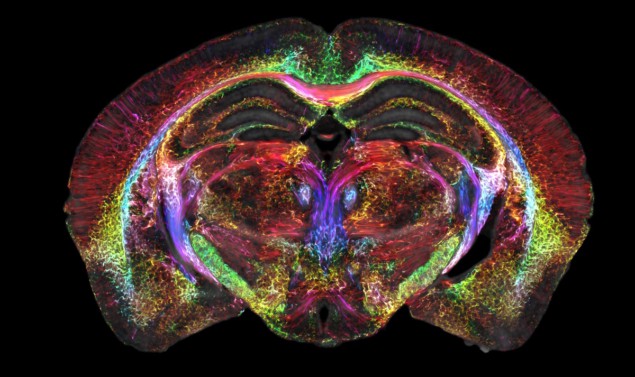Mouse brain imaging reaches record-breaking resolution
25 Apr 2023 Tami Freeman
Sharpest images ever Super-powerful MRI merged with light-sheet microscopy allows researchers to create a high-definition wiring diagram of the entire mouse brain. (Courtesy: Duke Center for In Vivo Microscopy)
A research team headed up at Duke Center for In Vivo Microscopy has created the highest-resolution MR images ever obtained of the mouse brain. The key to this breakthrough, which the team describe as “the culmination of nearly 40 years of research”, lies in the merging of magnetic resonance histology with light sheet microscopy.
The imaging technique, described in Proceedings of the National Academy of Sciences, could help improve our understanding of changes in the brain that arise from ageing or disorders such as Alzheimer’s disease.
To create the record-breaking images, the Duke researchers – working with colleagues at the University of Tennessee Health Science Center, the University of Pennsylvania, the University of Pittsburgh and Indiana University – first performed 3D MR histology of the mouse brain within the skull. They used a powerful 9.4 T MR scanner with coils that achieve gradients more than 100 times those of a clinical MRI system.
The researchers imaged the brain using gradient echo and diffusion tensor imaging (DTI) at 15 µm isotropic resolution – which they point out is roughly 1000 times higher than most preclinical DTI/MRI systems. The high-resolution MR data enabled creation of the most detailed MR connectivity maps ever achieved. They generated connectomes (a map of the neural connections in the brain) from track-density images with a super-resolution of around 5 µm.
Following the MR scanning, the researchers next imaged the brain using light sheet microscopy, an emerging technology that can produce 3D whole-brain images at cellular resolution. The technique allowed them to label specific groups of cells across the brain, such as dopamine-issuing cells, for instance, to visualize the progression of Parkinson’s disease.
An important enabler here was the ability to perform accurate image registration. The team used high-performance computing pipelines to merge the DTI with light sheet microscopy of the same specimen, providing a comprehensive picture of cells and circuits. This resulted in a so-called high-dimensional integrated volume with registration (HiDiver) with an alignment precision better than 50 µm.
Imaging the mouse brain
Track-density imaging of the entire mouse brain at record-breaking resolution. Courtesy: Duke Center for In Vivo Microscopy
Play Video
The researchers performed four experiments to develop and validate their HiDiver technique. First, they studied 90-day-old mice to create new 3D HiDiver reference atlases with 24 times the spatial resolution of any previous DTI atlas. They used a second set of mice to improve throughput and test the registration accuracy. The third experiment tested the robustness of HiDiver registration to variations in mouse genotype and age.
Finally, they performed a high-throughput study examining how different regions of the brain and strains of animal were affected by aging. One set of MR images, for example, showed how brain-wide connectivity changes as mice age, and how specific regions, such as the memory-involved subiculum, change more than the rest of the brain. Another set of images revealed brain connections that highlight the deterioration of neural networks in a mouse model of Alzheimer’s disease.READ MORE

The researchers say that new insights from mouse imaging will lead to a better understanding of conditions in humans, such as how the brain changes with age, diet, or even with neurodegenerative disorders such as Alzheimer’s or Parkinson’s diseases.
“It is something that is truly enabling. We can start looking at neurodegenerative diseases in an entirely different way,” says lead author G. Allan Johnson in a press statement.

Tami Freeman is an online editor for Physics World
FROM PHYSICSWORLD.COM 27/4/2023

Δεν υπάρχουν σχόλια:
Δημοσίευση σχολίου